Key Points:
- The Inseego Wavemaker is a new line of 5G cellular gateways and routers, targeting the enterprise market.
- The Wavemaker line includes a variety of form factors, all based on the same 2000-series 5G modem.
- Some Wavemaker models might be worth considering for nomads, RVers and cruisers.

Inseego is a very well-known company in the mobile cellular space, one that is most associated with manufacturing mobile hotspot devices for Verizon including 5G models like the M2000 (including the MiFi M2000 and M2100) series and 4G-era Top Picks like the 8800L.
But Inseego is expanding its product lineup with an eye toward the enterprise market, and it has now come out with a new line of "Wavemaker" enterprise-focused 5G gateways and routers.
Though the Wavemaker line is targeting enterprises and small businesses, some nomads might find the features and pricing appealing if they are trying to add 5G capabilities to their connectivity arsenals.
We've got all the details on the various Wavemaker options that are now trickling out to market.
Table of Contents
Wavemaker 5G Modem
All the Wavemaker models use the same core 5G modem module, based on the same modem design that powers the M2000 and M2100 mobile hotspots.
But the available bands and other features may be different, depending on the model and region it's sold in.
The modem is quite capable, supporting sub-6GHz 5G and the promise of millimeter-wave 5G support in the future. The new C-Band spectrum, band n77, is also supported - and the modem can operate in both non-standalone and standalone mode, depending on the available bands.
The modem, like most 5G modems available in hotspots and routers today, is based on the Qualcomm Snapdragon X55 chipset. As a second-generation 5G chipset, the X55 can give a true 5G experience but doesn't come with all the features and capabilities that will be available for 5G in the future. For more on 5G chipsets and 5G technology, see our most recent 5G industry update.
Additionally, the 5G modem also includes support for LTE at Cat-22 performance, which is at the pinnacle of what 4G/LTE can offer.
The Wavemaker 5G modem supports all the major cellular bands in use today. Here are the included bands:
- Sub-6 5G Bands: n1, n2, n3, n5, n7, n8, n12, n25, n28, n38, n40, n41, n46, n48, n66, n71, n77, n78, n79, n83
- mmWave 5G Bands: Not Yet Available
- LTE Bands: 1, 2, 3, 4, 5, 7, 8, 11, 12, 13, 14, 17, 18, 19, 20, 21, 25, 26, 28, 29, 30, 32, 38, 39, 40, 41, 42, 46, 48, 66, 71
Future models with mmWave 5G support are also expected, but details of which mmWave bands will be supported are not yet available.
Wavemaker Models of Interest
The Wavemaker product line has four models that are available now or coming to market soon that are of potential interest to nomads, RVers and cruisers:
Wavemaker FX2000 & FX2000e
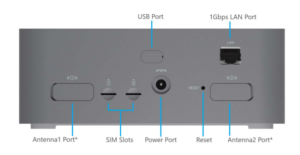
The Wavemaker FX2000 comes in two varieties - the standard FX2000 and the FX2000e. The only difference is that the FX2000e version has two SIM slots that can auto-switch from one SIM to another when a connection goes down.
In terms of form-factor and utility, this model is akin to a large mobile hotspot device, only lacking an internal battery.
Here are some features of interest:
- Simultaneous dual-band Wi-Fi that supports the Wi-Fi 6 (802.11ax) standard with internal 2x2 MU-MIMO antennas. Supports up to 30 Wi-Fi clients.
- 1x Gigabit LAN port.
- 1x USB C port that supports USB-tethering out to other routers
- 2x external TS-9 antenna ports for an external 2x2 MIMO antenna.
The single-SIM FX2000 model is an available option for T-Mobile Home Office Internet, a fixed-location business service, and is also sold by MobileBigFoot with their data plans.
The dual-SIM model is now available at some major cellular gear vendors for $699.
Wavemaker FG2000 & FG2000e
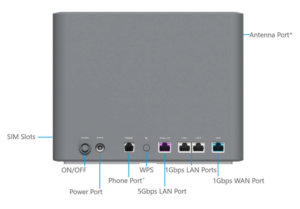
This is a bigger cousin to the FX2000 that includes different features in a similar-looking, but larger, design.
Like the FX models, FG2000 is single-SIM and the FG2000e is dual-SIM.
Here are the major features for this model:
- Simultaneous dual-band Wi-Fi that supports the Wi-Fi 6 (802.11ax) standard with internal 4x4 MU-MIMO antennas and support for up to 128 clients.
- 3x Ethernet LAN ports (1x 5 Gbps port and 2x 1 Gbps ports).
- 1x Gigabit Ethernet WAN port.
- 1x RJ-11 port for VoLTE voice phones (this port is not currently enabled but will be activated in a future firmware release).
- 2x TS-9 ports for an external cellular antenna.
Note that this model does not have a USB port for tethering.
US Cellular currently offers this model as part of its fixed wireless internet service, but is not yet shipping to consumer-accessible vendors.
Wavemaker FW2000 Outdoor CPE
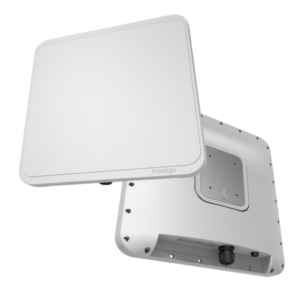 This model is intended to act as an outdoor mounted cellular gateway/CPE to feed a 5G cellular connection to an indoor router via a 5Gbps Ethernet port. The router is housed in a panel-shaped IP67-rated housing that is completely self-contained. The housing includes four tuned high-gain omnidirectional cellular antennas to provide 4x4 MIMO for the router.
This model is intended to act as an outdoor mounted cellular gateway/CPE to feed a 5G cellular connection to an indoor router via a 5Gbps Ethernet port. The router is housed in a panel-shaped IP67-rated housing that is completely self-contained. The housing includes four tuned high-gain omnidirectional cellular antennas to provide 4x4 MIMO for the router.
The only power option is via PoE, so the single 5 Gbps Ethernet port provides power to the router and also the downstream data connection to an interior router, which is not included. Other than the Ethernet port and two SIM slots, this model has no other connectors or ports and it also lacks any Wi-Fi.
This version is also sub-6GHz 5G only, and will not have an option for mmWave support.
An important consideration is that this device is quite large (17 x 15.75 x 2.8 inches) and hefty (9.3 pounds) which would make it a challenge to install on vehicles and RVs.
Wavemaker S2000e 5G Industrial Gateway
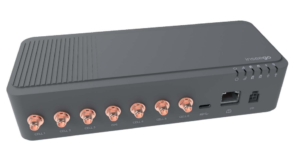 The S2000e is designed to be a cellular 5G gateway to provide connectivity for vehicles or for remote and high-temperature locations like server rooms or factories. The wide temperature range means it can also be installed outdoors in a weatherproof enclosure. It does not have any Wi-Fi capability.
The S2000e is designed to be a cellular 5G gateway to provide connectivity for vehicles or for remote and high-temperature locations like server rooms or factories. The wide temperature range means it can also be installed outdoors in a weatherproof enclosure. It does not have any Wi-Fi capability.
One unique aspect of the S2000e gateway is that it has six cellular antenna ports - a very unusual design. 5G and LTE Routers usually have 4 ports to provide 4x4 MIMO, but the S2000e has 6 that are frequency tuned:
- 2x antenna ports support the full 600MHz - 6GHz cellular range
- 2x ports are tuned to the 1.4GHz - 6GHz range
- 2x ports are tuned to the 3.3GHz - 6GHz range
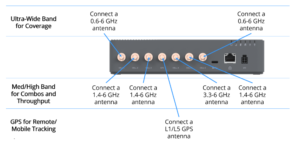
Inseego sells paddle antennas that are optimized for this tuning. But the obvious downside is that this design is not a good match for the vast majority of rooftop cellular antenna designs, which either have 4 antenna elements for 4x4 MIMO or 2 elements for 2x2 MIMO. Conceivably one could mix-and-match antennas to support this gateway, either using a 4x4 MIMO antenna and a 2x2 MIMO antenna, or three 2x2 antennas.
Another question is how this gateway supports 4x4 MIMO with six antennas. The S2000e datasheet explains it this way:
...the S2000e supports 4x4 LTE + 5G or 4x4 5G + LTE as well as 4x4 LTE or 4x4 5G so you can maintain a dependable connection compared to other devices. With six cellular ports, each port is tuned to optimize efficiency and return loss to provide the best possible RF.
So it seems like the S2000e is able to mix and match which antennas to use to achieve 4x4 MIMO on either 5G or LTE.
Here are some of the other features of the S2000e Gateway:
- 1x 5 Gbps Ethernet port that can also power the S2000e via PoE
- 1x USB C port that can be used for USB tethering out to other devices
- Power options include PoE or a 4-pin GPIO connector for AC or DC power
- 2x SIM slots
Wavemaker Firmware
Enterprise-level products are something new for Inseego, and they have a ways to go before they can compete with the advanced features offered by Pepwave, Cradlepoint, and others.
The firmware for this router line appears to be derived from their mobile hotspot firmware, with a few enterprise features added on - such as remote management via Inseego's cloud-based service called Inseego Connect. The dual-SIM models also offer a basic automatic SIM switching function that provides a limited automatic fallback capability.
Unfortunately, some key features we like to see in high-end enterprise devices are missing from Inseego's current firmware:
- Band-locking - The Wavemaker series lacks band-locking capabilities - this is a fantastic feature for tuning a connection to get the best performance.
- Usage Tracking - Usage tracking is only available as part of the subscription-based remote management service, Inseego Connect.
- Wi-Fi-as-WAN - The models that include Wi-Fi are not capable of connecting to other Wi-Fi access points to provide an alternative internet connection.
- Limited Network Options - The Wavemaker line does not have some of the advanced networking and routing features that other enterprise routers have. But Wavemaker devices are primarily intended to be gateways that supply a cellular connection to routers that could have these features.
Is the Wavemaker Line Viable for Mobile Users?
![]() Inseego is specifically marketing these models to enterprise users who need high-speed cellular connections at fixed and remote locations for business use.
Inseego is specifically marketing these models to enterprise users who need high-speed cellular connections at fixed and remote locations for business use.
The Qualcomm X55-based modems are very capable and cover all sub-6GHz 5G bands and LTE Bands, but will lack carrier aggregation across mid and low band spectrum. Future Wavemaker models will also offer support for mmWave 5G.
Most Wavemaker models are priced low enough that they might appeal to more mainstream users looking to add 5G to their connectivity arsenal.
But each of these options comes with some significant tradeoffs, and the whole line suffers from the basic firmware the lack of dual-modem options available from other manufacturers.
Here are some thoughts on the specific models:
The dual-SIM FX2000e retails for $699, the same price as Netgear's recently released MR5200 5G mobile hotspot device. The Netgear, as it is a mobile hotspot, is smaller and can be battery-powered. The FX2000e is larger, supports more cellular bands, is slightly more advanced for LTE (Cat-22 vs Cat-20 on the Nighthawk), and has dual-SIM's. However it's really best looked at as a mobile hotspot device without a battery as the 2x2 T-S9 antenna ports are limiting in reducing the 4x4 MIMO capability of the modem and choices in antennas that have native T-S9 connectors.
For those who do not need battery power and the small form-factor of a mobile hotspot device, the FX2000e might be the better choice.
The FG2000e is an additional $300, at $999 (but is not yet shipping).
For that $300, USB out tethering capability is lost, but the gains include faster Wi-Fi and more router functionality via more LAN ports and a WAN port.
The FG2000 and FG2000e are the only two models in the lineup with multiple Ethernet LAN ports and a WAN port.
The FW2000 Outdoor CPE, given its size and weight, would be challenging for many mobile and nomadic installations. And at $1299 it is also the most expensive device in this lineup.
Finally, the S2000 is a very interesting device and is the only model in the line with external antenna ports capable of providing 4x4 MIMO with an external antenna. All the other indoor models have 4x4 MIMO internal antennas with some offering two ports for 2x2 external MIMO. At $799 it is affordably priced for a 5G Gateway.
But the six antenna port design with tuned frequencies for each port makes utilizing the S2000 challenging and uncertain with the available antenna options that most nomads are interested in. But with the right antennas, this design could provide a better signal to the 5G modem thanks to greater gain and signal optimization.
Overall, the Wavemaker line comes with a lot of compromises for nomadic users looking for high-end connectivity, but those who are willing to accept the downsides may find one of the Wavemaker models a capable 5G cellular solution.
Other 5G Options to Consider
Those looking for 5G in a router or gateway have a few other options and brands to consider:
- Pepwave: The new MAX BR1 Pro 5G is much more of a router and also has upgraded internals making this a speed demon - but at $1,499, that extra power and Pepwave's great firmware comes at a significantly higher price point.
- Insty Connect: The Insty Connect Explorer 5G20 utilizes a unique rooftop cellular modem and antenna design connected to an indoor router via USB. It's designed by an RVer for RV use and is priced at $999.
- Cradlepoint: Cradlepoint now has several 5G offerings, but the company has moved away from consumer-friendliness and they also now require a Netcloud subscription to make even basic router changes - an ongoing and unavoidable cost that is a significant downside.
- MOFI: The new Mofi 5500 routers come with two 5G modem options for $649 or $699 - but we are not fans of MOFI's confusing and often buggy firmware.
Related News Stories
Related Guides & Info
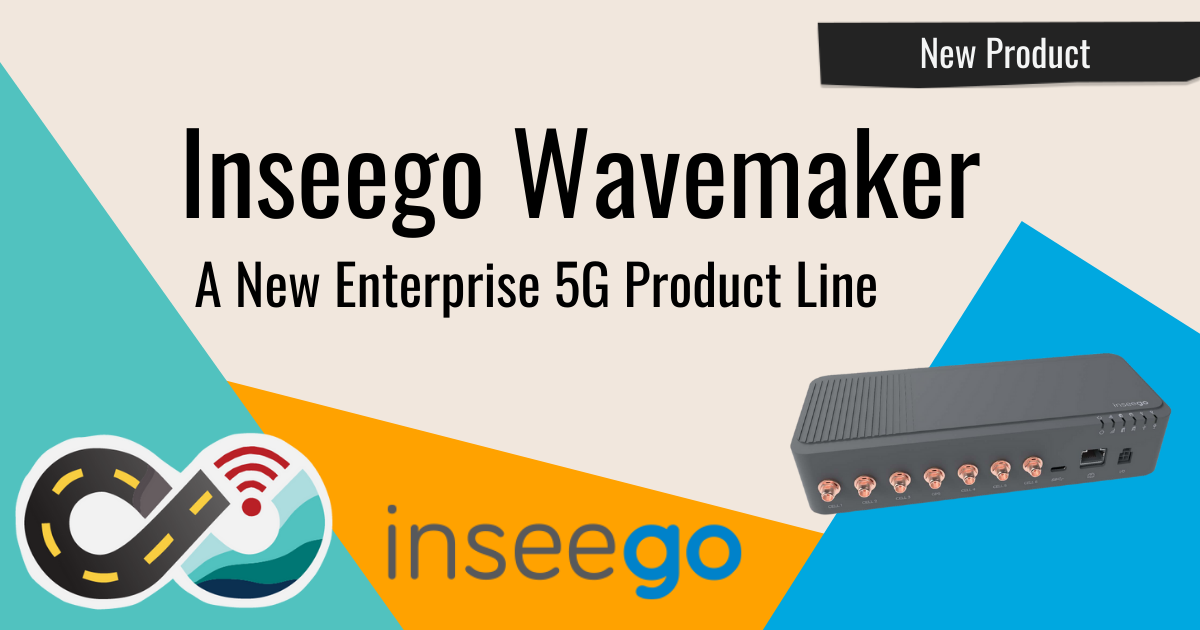







 Mobile Internet Resource Center (dba Two Steps Beyond LLC) is founded by Chris & Cherie of
Mobile Internet Resource Center (dba Two Steps Beyond LLC) is founded by Chris & Cherie of